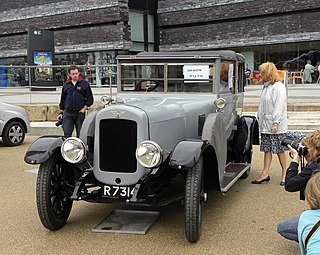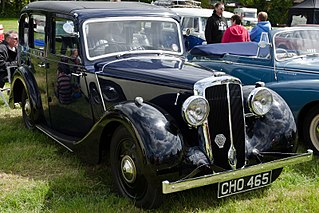The Lanchester Motor Company Limited was a British car manufacturer in active trade between 1899 and 1955. Though the Lanchester Motor Company Limited is still registered as an active company and accounts are filed each year, the marque has been dormant since. As of 2014 it is marked as "non-trading".
The Xtra was an English three-wheel cyclecar launched at the Olympia show in November 1921 and built until 1924 by Xtra Cars, Ltd., of London Road, Chertsey, Surrey.

The Riley Nine was one of the most successful light sporting cars produced by the British motor industry in the inter war period. It was made by the Riley company of Coventry, England with a wide range of body styles between 1926 and 1938.
The Rover 8 was a small single-cylinder 8 hp 1327 cc car made by the British Rover car company. It was Rover's first production car. It was remarkable for being supported by a backbone chassis rather than a conventional ladder frame. The first model was manufactured from 1904 to 1912. A Daimler-Knight sleeve valve engine option was available on the original model in 1911 and 1912.

The Austin 10 hp is a high-quality small car produced between 1910 and 1915 by the British car manufacturer Austin Motor Company Limited at their Longbridge, Worcestershire plant near Birmingham. 1,336 cars were made, 213 with the 1125 cc engine and 1,123 with the 1615 cc engine. Like the 1087 cc Austin 7 hp produced by both Austin and Du Cros's Swift Motor Company it was not very successful when sold with the small engine.

The Hillman Fourteen is a medium-sized 4-cylinder car announced by Hillman's managing director Spencer Wilks, a son-in-law of William Hillman, at the end of September 1925. This new Fourteen substantially increased Hillman's market share and remained on sale into 1931. During this time it was the main product of the company.

The Rover 12 was a name given to several medium-sized family cars from the British Rover car company between 1905 and 1948.

The Vauxhall 30–98 is a car manufactured by Vauxhall at Luton, Bedfordshire from 1913 to 1927. In its day, its best-known configuration was the Vauxhall Velox standard 4-seater with open tourer body. Vauxhall's own description was the 30–98 hp Vauxhall-Velox sporting car. The 30–98 is also known to enthusiasts by Vauxhall's chassis code E.

The Vauxhall 25 h.p. chassis code D type is a car manufactured by Vauxhall from 1912 to 1922. More than 1,500 were supplied to the British Army in World War I for use as staff cars. Each Vauxhall chassis was sold with a three-year guarantee including regular inspections.

Austin Twenty is a large car introduced by Austin after the end of the First World War, in April 1919 and continued in production until 1930. After the Austin 20/6 model was introduced in 1927, the first model was referred to as the Austin 20/4.

The Lanchester Ten and Lanchester Eleven were sold by The Lanchester Motor Company Limited from the Ten's announcement in September 1932 until 1951. Quite different from previous Lanchesters, the Ten was the second of Lanchester's new owner's new Daimler-linked Lanchester range. The names Ten and Eleven referred to the engine's rating for the annual tax and did not relate to the engine's power output.

The Lanchester Eighteen at first known as the 15/18 was announced at the beginning of October 1931. Quite unlike any previous Lanchester it was their first new car following BSA's takeover of The Lanchester Motor Company Limited in January 1931. A medium sized car was a new departure for Lanchester.

The BSA Ten is a small car manufactured for BSA Cars by BSA subsidiary The Daimler Company Limited. Announced in October 1932 first deliveries were delayed until February 1933. A cheaper and less well-finished version of the Lanchester Ten with a smaller side-valve engine of BSA design. An offering to try to meet the market of the Great Depression.

The Lanchester Fourteen Roadrider is a six-cylinder automobile introduced by the Lanchester Motor Company in the beginning of September 1936. It was named "Roadrider" for its special suspension features, and billed as the lowest-priced six-cylinder Lanchester ever offered. This car replaced the previous 12 hp Light Six model with a larger six-cylinder engine again in the Lanchester Eleven chassis and body.

The Austin 40 hp is a 4-cylinder motor car launched at the Olympia Motor Show in November 1907. Manufactured by Austin at Longbridge, Northfield, Birmingham, it was the first variant from Austin's initial plans for a two model range of a 15 hp —which they had dropped—and a 25 hp car.

The Vauxhall 23-60 is a four or five-seater touring car manufactured by Vauxhall of Luton that was announced in July 1922. The 23-60's standard tourer Kington body was described as "preserving that greyhound look so characteristic of the Vauxhall car". It shared many parts with Vauxhall's much more powerful 30-98.

The Vauxhall 20-60 is a four or five-seater saloon, limousine, tourer or coupé-cabriolet manufactured by Vauxhall of Luton. It was announced on 28 September 1927 with a six-cylinder engine and a four-speed gearbox. A cautious move downmarket. "The first time any six-cylinder Vauxhall has been sold under £1000!" "British & Vauxhall". The initial 2.7-litre engine was enlarged to 3-litres after twelve months.

The Morris Oxford Six is a motor car produced by Morris of the United Kingdom from 1921 until 1926, and again from 1929 until 1935. Initially produced as a straight-six engined version of the Morris Oxford bullnose, the original Oxford Six was the first car produced by Morris with a six-cylinder engine, but proved to be unreliable. The versions produced from 1929 onwards were introduced as a replacement for the Morris Oxford 16/40.

The "bullnose" Morris Oxford is a series of motor car models produced by Morris of the United Kingdom, from 1913 to 1926. It was named by W R Morris after the city in which he grew up and which his cars were to industrialise.
The Hillman Straight Eight and its successor the Hillman Vortic were moderate priced mid-sized 20 tax-horsepower executive cars made by Hillman from 1929 to 1930. The lowest priced eight-cylinder car on the market the car was scarcely in full production when sales were hit by the onset of the Great Depression.





















